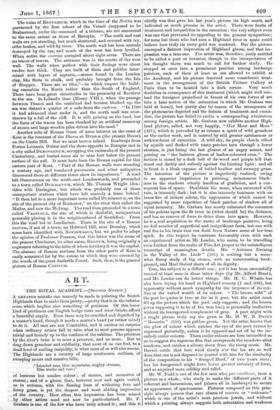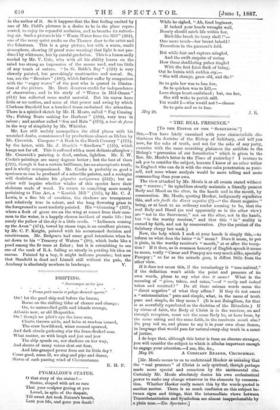ART.
THE ROYAL ACADEMY.—[SEcoNo NOTICE.]
A GREATER mistake can scarcely be made in painting the Scotch Highlands than to make them pretty,—pretty that is in the inferior sense which implies also something of pettiness. Of this lesser kind of prettiness our English hedge-rows and river-brinks afford a bountiful supply. Even these may be ennobled and dignified by a master's hand, though it needs a master's hand (or rather mind) to do it. All men are not Constables, and it excites no surprise when ordinary artists fall to raise what to most persons appears trivial and homely up to the confines of the sublime. The primrose by the river's brim is to most a primrose, and no more. But to drag down grandeur and sublimity, that most of us can feel, to a dead level of smiling insipidity, is what most of us will also resent. The Highlands are a country of large continuous outlines, of sweeping moors and massive hills,
"Islanded seas, blue mountains, mighty streams, Dim tracks and vast ;"
of lustrous but sombre colour ; of storms, and memories of storms ; and of a gloom that, however now and again varied, as in autumn, with the flaming hues of withering fern and fenny grass, is yet the deepest and most abiding impression of the country. How often this impression has been missed by other artists need not now be particularized. Mr. P. Graham is one of the few who have truly echoed it ; and this it
chiefly was that gave his last year's picture its high merit, and indicated so much promise in the artist. There were faults of treatment and inequalities in the execution ; the very subject even was one that prevented its appealing to the general sympathies ; for none but those who had seen a Highland river in spate could believe how truly its rusty gold was rendered. But the picture conveyed a distinct impression of Highland gloom, and that im- pression was a true one. The artist was, therefore, justly entitled to be called a poet or inventor, though in the interpretation of his thought there was much to call for further study. He stepped at once into a prominent position among landscape painters, such of them at least as are allowed to exhibit at the Academy, and his picture deserved more considerate treat- ment in the arrangement of the British Picture Gallery at Paris than to be hoisted into a dark corner. Very much doubtless in consequence of this treatment (which might well mis- lead the foreigner prejudiced in favour of his own forms of art • into a false notion of the estimation in which Mr. Graham was held at home), but partly also by reason of the strangeness of the phenomena depicted and the defects of treatment and execu- tion, the picture has failed to excite a corresponding admiration among foreign artists. Mr. Graham now exhibits another High- land picture, called, not very happily, "O'er Moor and Moss" (461), which is pervaded by as intense a spirit of wild grandeur as the earlier work, and is marred by still greater carelessness or awkwardness of execution. A wild sky, its purple clouds rifted by squalls and flecked with rusty patches torn through a lower stratum, is just losing the last gleams of an angry sunset, and putting on "the lustrous gloom of leaden-coloured even." The horizon is closed by a dark belt of fir-wood and purple hill that stand out darkly and sullenly against the fainting light ; and all in front is a bleak expanse of tufted heather and swampy gratis. The intention of the picture is imperfectly realized, owing to an apparent impatience in painting, monotonous black- ness in the shadows utterly heedless of gradation, and a con- sequent loss of space. Doubtless the moor, when saturated with rain, is intensely dark : but it is also intensely luminous with an inner fire of richest colour, the appearance of which cannot be suggested by mere repetition of black patches of shadow all of equal intensity. Mr. Graham has nearly exhausted the resources of his palette upon the fir trees in (what should be) the distance, and has no reserve of force to drive them into space. However, he is a real acquisition to the ranks of landscape painters, being no dull retailer of superficial and insignificant facts, but one with real fire in his brain that can distil from Nature some of her true spirit. In this respect he contrasts favourably even with such an experienced artist as Mr. Leader, who seems to be travelling even further from the realm of Fine Art proper to the unintelligent transcript of meaningless details. His "Autumn Evening in the Valley of the Lledr " (501) is nothing but a some- what flimsy study of big stones, with an uninteresting back- ground, and Mod l Siabod shorn of all its dignity.
True, the subject is a difficult one ; yet it has been successfully treated at least once in these latter days (by Mr. Alfred Hunt), and Mr. Leader can do better things. Mr. H. C. Whaite has also been trying his hand at Highland scenery (1 and 208), but apparently without much sympathy for the largeness of its out- line or the varied wealth of its colour. "The brown wild" of the poet he quotes is true as far as it goes, but the artist must fill up the picture which the poet only suggests ; and the brown (even supposing it to be of the true hue) is pictorially ineffective without its interspersed complement of gray. A poet might with a single phrase truly say the grass in Mr. II. W. B. Davis's " Moonrise " (536) was golden-green. Yet the artist knows that the glow of colour which catches the eye of the poet cannot be expressed pictorially, unless it be opposed and set off by the (so- called) cooler colours. These cooler colours are here intensified so as to suggest the vaporous film that overspreads the meadows after sundown, and catches a silvery sheen from the rising moon. Mr.
Davis's cattle that here wind slowly o'er the lea are so well done that one is not disposed to quarrel with him for the similarity of the composition to his "Strayed Herd," of two years since; but his foreground might have borne greater certainty of form, and so acquired more solidity and relief.
Mr. W. Field is one of the few men who, par excellence, treat a picture as a whole ; who study to make the different parts of it coherent and harmonious, and (above all in landscape) to secure an appearance of spaciousness. Pictures composed on this prin- ciple always possess that rare charm of reserve or " reticence " which is one of the artist's most precious jewels, and without which a painting always suggests both ostentation and weakness in the author of it. So it happens that the first feeling excited by one of Mr. Field's pictures is a desire to be in the place repre- sented, to enjoy its reposeful seclusion, and to breathe its refresh- ing air. Such a picture is his "Waste Water from the Mill" (234), one of the many quiet nooks on the Thames dear to the artist and the fisherman. 'Phis is a gray picture, but with a warm, sunlit atmosphere, showing (if proof were wanting) that light is not pro- duced by whiteness, but by careful gradation. This is a lesson sadly needed by Mr. V. Cole, who with all his ability leaves on the mind too strong an impression of the means used, and too little of any touch of nature. "In St. Bride's Bay" (524) is very cleverly painted, bat provokingly unattractive and unreal. So, too, are the " Breakers " (489), which further suffer by comparison with the "angry waves" of the poet who is quoted in illustra- tion of the picture. Mr. Brett deserves credit for independence of observation ; and in his study of "Waves in Mid-Ocean" (614) has collected some useful material. But his waves have little or no motion, and none of that power and swing by which Clarkson Stanfield has a hundred times enchained the attention. There is a spirited sketch by Mr. 11. Moore, called" Fog Coming On; Fishing Boats making for harbour" (588), very true in colour ; and another called "Sea and Rain" (670), a tour de force in the way of simplicity by Mr. Whistler.
Mr. Lee still unduly monopolizes the chief places with his wretched daubs, countenanced by productions almost as lifeless by Mr. Creswick. Compare "A Beck in the North Country "(173), by the latter, with Mr. J. Dearle's " Sundown" (155), which hangs not far off. This is suffused with a most delicate afterglow ; Mr. Creswick's painting is dead, sunless, lightless. Mr. E. W. Cooke's paintings arc many degrees better ; but the best of them (223), though it has a certain brilliance, has no atmospheric truth, and is wholly unimpassioned. Mr. Cooke is probably as good a specimen as can be produced of a scientific painter, and a zoologist will doubtless admire his physalus antiguorum (512) ; but an artist will inquire whether whales of this species have their skeletons made of wood. To return to something more nearly pertaining to Fine Art, a "Kentish Mill" (105), by Mr. C. J. Lewis, is a fine bit of sunshine, the shadows are transparent and relatively true in colour, and the long flowering grass in the foreground is most tenderly painted. His " Gloaming " (337), where a flock of geese are on the wing at sunset from their com- mon to the water, is a happily, chosen incident of rustic life : but surely the yellow of the sky is a little crude. " Indiaanen coming up the Avon" (474), towed by steam tugs, is an excellent picture, by Mr. C. P. Knight, painted with his accustomed decision and sensitiveness. Mr. Redgrave had some good intentions when he sat down to his "Treasury of 'Waters " (90), which looks like a pond among the fir trees at Esher ; but it is astonishing to see one of the rank of R.A. failing so utterly in putting his idea on canvas. Painted by a boy, it might indicate promise; but now that Stanfield is dead and Linnell still without the pale, the Academy is absolutely nowhere in landscape. V.































 Previous page
Previous page